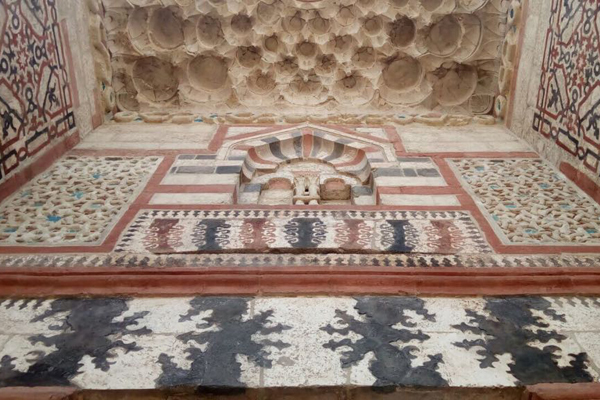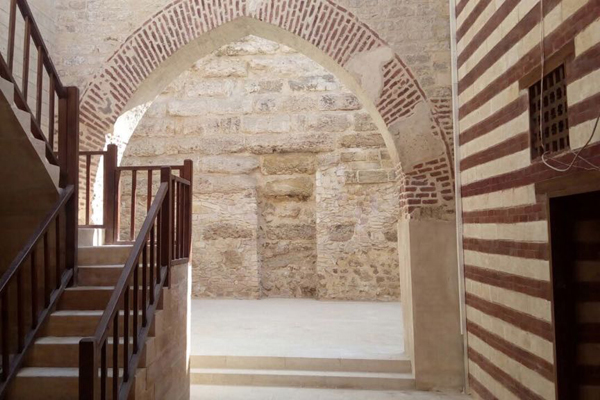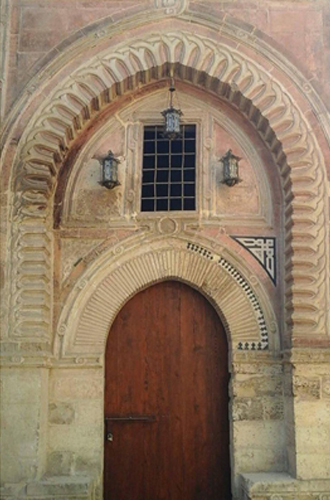http://english.ahram.org.eg/News/288033.aspx
Egyptian monuments reopen
Three Mameluke monuments in Islamic Cairo are to be reopened to the public after restoration

Three Mameluke-period monuments, the Al-Muayyedi Bimaristan, the Tekkeyet Al-Bustami and the Darb Al-Laban Gate in Islamic Cairo are to be reopened to the public next week after restoration work.
A Bimaristan is a Mameluke hospital, while a tekkeya is a Sufi charitable building. The buildings have been shrouded in scaffolding for the past three years as restoration work continues, with it being slated to finally come off next week.
The monuments, like others in heavily populated areas, were suffering from environmental dangers, including air pollution, high subsoil water levels, high levels of humidity, water leakage, the effects of a decayed sewerage system installed 100 years ago, and the adverse effects of the 1992 earthquake that increased the number of cracks in their walls, leading in some cases to partial collapse.
"One of the most serious causes of the damage to the buildings has been encroachment from the monuments' neighbours who used the tekkeya for example as a residential building and the bimaristan as a garbage dump," Mohamed Abdel-Aziz, director of the Historic Cairo Rehabilitation Project that supervised the work, told Al-Ahram Weekly.
He said the walls of the three monuments had cracked and partly collapsed, masonry was damaged, and the condition of the ceilings was critical. Decorations were heavily damaged and several parts were missing, while most of the flooring was broken.

Minister of Antiquities Khaled El-Enany said the restoration had been carried out according to the latest scientific methods. "Every effort was made to ensure that all the original architectural features were retained," he said, adding that the restoration of the buildings had had important advantages in that individual monuments were being preserved for future generations and the entire neighbourhood was being revived and upgraded.
Abdel-Aziz said that the aim of the restoration was mainly to strengthen and consolidate the monuments and protect them from future damage. The walls were reinforced, cracks were treated, façades were consolidated, missing and decayed stones were replaced, and masonry was cleaned and desalinated. Tilted pillars and walls were readjusted to their original positions, broken woodwork was re-installed and missing parts were replaced with others of the same shape, size and material.
The ceilings were consolidated and insulated with special material to prevent the leakage of rainwater into the monuments. A special system was also designed to accumulate rainwater in one place and feed it into the main sewage system.
The areas surrounding the three monuments were cleaned, restored and upgraded in order to be venues hosting cultural events as well as for holding workshops to raise the cultural awareness of their inhabitants.

The Al-Muayyedi Bimaristan was built by one of the most important Circassian Mameluke sultans to rule Egypt, Al-Muayyad Sheikh Al-Mahmoudi, who reigned between 1418 and 1420 CE. The Bimaristan is the second public hospital still remaining from the period after that of the Mameluke sultan Qalawun built in 1284 in Al-Muizz Street in Islamic Cairo.
The Al-Muayyedi Bimaristan is noted for its monumental scale, unprecedented in a civic building, which was clearly inspired by the nearby free-standing sultan Hassan Madrassa, and also for its portal, which is set in a distinguished Persian character façade. The portal has a muqarnas hood (stalactite decoration) and a window with a pair of colonnades featuring a snake as a symbol of healing.
The Bimaristan is located in the Darb Al-Laban area on the site of the sultan Al-Ashraf Shaaban Madrassa, founded in 1367 and demolished by sultan Farag Ibn Barquq in 1411 and used as a military garrison to protect the nearby Citadel if it came under siege during times of trouble.
Al-Muayyad Sheikh Al-Mahmoudi rebuilt theBimaristan on the remains of the Al-Ashrafiya Madrassa (school). The building is a shell and has lost many sections of its outlying structure. The area in front was levelled in 2005 by the then Supreme Council of Antiquities to allow a full view of the façade.
The complex originally included the remains of a mosque, three minarets, two mausoleums and a madrassa. The two-storey structure was divided into male and female sectors, with a timber-roofed middle hall and four iwans (vaulted open chambers) with pointed arches. A manuscript describes it as originally having 25 chambers plus four secluded rooms for special patients, as well as a pharmacy, library and a small mosque.
Near the entrance there was asabil (drinking fountain), a school for orphans and a third smaller mosque. The hospital fell into disuse following the sultan's death. Today, its upper floor is missing, but the main façade reflects the wonderful proportions and ornamentation of the Mameluke period.

During the restoration work, Abdel-Aziz told the Weekly, conservators had stumbled upon a tunnel connecting the Bimaristan to the Tekkeyet Al-Bustami as well as a cistern under the mosque and a well under the men's section. A distinguished plaque had been found decorated in light and dark blue elements and bearing the name of Al-Muayyad Sheikh Al-Mahmoudi in Kufi Arabic writing.
The Tekkeyet Al-Bustami was originally built by the tenth Circassian and 34th Mameluke sultan of Egypt, Seifeddin Abu Saad Gakmak, for Sufis coming from Bukhara in Central Asia in 1443 CE.
Abdel-Aziz said thetekkeya was originally a small mosque built by the sultan Mohamed Ibn Qalawun for a sufi named Taqieddin Al-Bustami from Persia who lived in it until he passed away. It has a central open court, and around it are several structures, among them a small mosque, a madrassa, a garden leading to the nearby Bimaristan through the newly discovered tunnel.
During the restoration work, engravings revealing calculations and mathematical exercises were uncovered, as well as a cistern and a burial area.
The Darb Al-Laban Gate was built in limestone during the Bahari Mameluke era and located beside the tekkeya. It consists of a gate which is the oldest of those that once marked the entrance to many Islamic City alleys.
The gate has a small-decorated widow with iron bars to allow the entrance of air and light. It is decorated with wooden and stone decorative elements with geometric designs.
This article was originally published in Al-Aham Weekly
Sent from my Linux system.
No comments:
Post a Comment